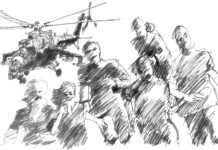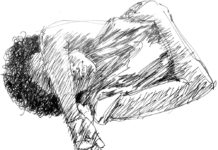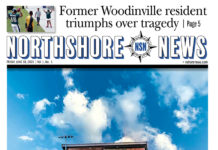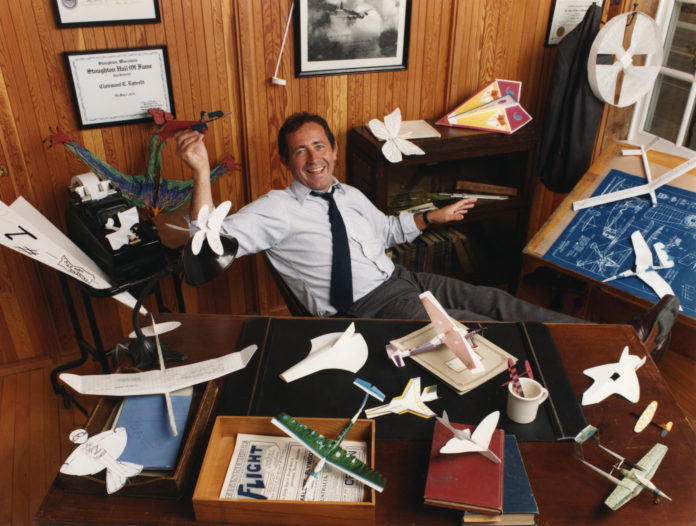Pub. Note: Howard Lovering is still his ever-witty, self-deprecating self. After seeing our post about his Pathfinder Award (which got about quadruple the average number of hits, by the way), he wrote the following reply about an event that I’d, frankly, long forgotten about. My thanks to Howard for the welcome reminder.
Thanks for the Pathfinder Award article, Larry. You always are generous toward old friends. I’ve noticed now that not as many of my old acquaintances cross the street when they see me coming. And no, that photo of me is not from my high school annual. If you look at the full picture from which the headshot was cropped (above), you should remember the occasion. If not, I must remind you.
That photo was for the promotion of the Museum of Flight’s Second Great International Paper Airplane Contest in 1985, during which you provided me some support and advice. The event was a spectacular success—in spite of your help. Let me remind you of your involvement.
The Museum of Flight was an upstart, deep into the capital campaign to build the Great Gallery and finish the initial complex. At the time, we had only the Red Barn with exhibits and a small staff and little budget, but we worked hard to gain relevance and prove value to the community. We continually searched for affordable projects of interest. Our events budget was petty cash. We did not have enough money to buy a dozen day-old donuts at the nearby minimart. But our imaginative staff came up with ideas, such as the venture we had with Mick McHugh to bring in Concorde to Boeing Field in 1984 that made national headlines. Events such as these kept the museum relevant, while also building brand, and in this case, it was a paper-airplane contest.
A staffer noticed that Scientific American magazine had promoted a semi-serious First Great International Paper Airplane Contest a decade earlier that received a lot of attention. We decided to reenact the event on a shoestring. Scientific American, probably reading the museum’s Dun & Bradstreet, declined to participate, but the newcomer, Science 85 magazine, thought it a good idea for them to become prime sponsor. A Japanese maker of paper-airplane kits kicked in some dough. The Smithsonian National Air & Space Museum agreed to a no-investment professional partnership, and we launched. We never imagined the broad reach and success this simple contest would enjoy.
Operating bare-bones, as usual, I called on various professionals for volunteer their help, and one of them was my new friend, Larry Coffman. In your typical enthusiasm, you thought it a good idea and gave me advice, including how essential it was to communicate and promote through media to deliver the story. You even found a colleague to volunteer services in preparing promotional print pieces, hence the attached photo, which was taken on the second floor of the historic Boeing Red Barn building to suggest the fun and of this event…no static standups for us.
In short, the event took off like a rocket, not a paper airplane. With a measure of what I will call communications, the contest became large scale, while easy to manage and relatively inexpensive. The media seized on it as fun and timely, and the narrative content was diverse. The response was global. Within weeks, the museum had more than 5,000 entries from 29 countries, and most were doozies, beautifully packaged with detailed instructions for how to be flown by our volunteers. When we welcomed our celebrity panel of judges—including astronaut Michael Collins—and volunteer flyers to the Kingdome for the contest, at your suggestion, we held a short press conference. We were surprised at all the media who showed up with cameras and mics, and I also remember seeing you in the front row wearing a big smile.
That event was a monster success, done on a tiny budget. The contest and stories of the winners became one of the national soft-news stories of that year, culminating in our project manager and the editor of Science 85 appearing on Late Night With David Letterman. It was just one of the unusual special events that served to define the success profile of the Museum of Flight.
A chapter in my recent book, For Future Generations/A History of the Museum of Flight, contains a more detailed description of the paper-airplane contest. But, again, when I saw your posting about the award and the accompanying photo, all of these memories came flooding back. Thank you for that, too.
Howard
Howard Lovering Honor
Pub. Note: The Museum of Flight’s Annual Pathfinder Awards honor individuals with ties to the Pacific Northwest who have made significant contributions to the development of the aerospace industry. Categories include Flying, Education, Operations, Engineering, Manufacturing and At-Large. Pathfinder Award recipients are selected by The Museum of Flight, the Pacific Northwest Section of the American Institute of Aeronautics and Astronautics and representatives of other aviation and aerospace organizations and companies throughout the Northwest. Seattleite Howard Lovering is one of five inductees in the class of 2020 and recognized in the At-Large category. The 39th Annual Pathfinder Awards banquet is scheduled for Oct. 20, if COVID-19 conditions permit.
THE MUSEUM OF FLIGHT is the largest non-governmental air and space museum and the foremost aerospace education center in the world. Its collections, programs, staff and volunteers have served and inspired millions of students and visitors for more than 50 years. Few know of the Museum’s rocky beginnings, and how, without the dogged persistence of one man, it may have never happened.
In the late ’60s, Boeing Chairman William M. Allen was pitched the idea of a flight museum by Boeing historian Harl Brackin and others in a small organization known as the Pacific Northwest Aviation Historical Foundation (PNAHF). Allen was interested but was unsure of the project’s viability. After his retirement, Allen used his influence to explore the museum’s potential. In 1975, Howard Lovering was assigned as a Boeing loaned executive to complete a study of the project. Completed on a tight schedule, the assessment found that a museum was feasible and of consequence as an educational center, only if located at Boeing Field. This early work committed what was to become the mission for the institution.
Continuing to serve on the Museum’s Board of Trustees and as a volunteer, Lovering assisted the effort to save the original manufacturing building—the Boeing Red Barn—and relocate it to temporary storage at Boeing Field. Recruited by Bill Allen, Lovering then took a leave of absence from the company to serve as the first executive director and staff of one for The Museum of Flight. Lovering was eager to seize this opportunity to build an enduring institution from scratch. In its infancy, it was clear the community would not buy the case alone, nor would or could The Boeing Company. Needed was joint support, a prime property and a lot of money—an overwhelming exercise for a small organization with few funds.
Lovering found the funds to pay his salary and carved out a small budget for planning and operations. A few donors came forward during this critical time of “go-or-no-go,” allowing the project to continue. With Lovering in place and a modest amount of money in hand, it was time to reorganize for the next series of battles. The Red Barn was deteriorating on its temporary site at Boeing Field, and it was entirely possible at this point that the project would fail.
A donor provided office space in downtown Seattle, and Lovering hired two part-time assistants. The small but determined staff made progress, upgraded PNAHF’s small initial aviation museum at the Seattle Center, organized outreach programs and persevered in the mission to create a flight museum. Each step of the journey provided momentum for the next, and it was a long climb.
A pivotal moment in the development of the new museum happened in 1978. As the Boeing Red Barn languished, and with the museum’s presence at Seattle Center coming to a close, it was clear that the museum required land, and the audacious ask was for seven prime acres on Boeing Field.
The expected response was push-back from airfield management, in addition to legal woes, as eminent domain action was required to acquire the necessary private parcels. Lovering answered the subpoena to represent the museum in court, sans attorney. It was a surprise when the judge ruled in favor of the land for public use, with the museum included as an airport-related activity.
This was not the end of the struggle, but it was a turning point. With the prime property, the Red Barn was restored with growing corporate and community support, allowing the first-phase opening in 1983. This successful opening leveraged the continuing capital campaign to build out the full property—to include the iconic T.A. Wilson Great Gallery. Community support included corporate donors from bottom to top, private philanthropy and considerable national investment. The momentum had built to a large and dedicated force, with strong leadership. With the Great Gallery opening in 1987, replete with Vice President Bush and Apollo astronauts, the brand of quality and service was established. The exceptional public popularity ensued and has continued over decades of expansion.
The Museum of Flight exists today because of many influential people and their crucial contributions. Yet, Lovering’s ongoing conviction that an aerospace museum should educate and his determination and utter refusal to let the project fail in the face of numerous obstacles were the essential reasons it succeeded.
Leaving the Museum in 1992, Lovering and his wife established LOGIC, a museum consulting company, with their first assignment to manage the acquisition and move of the Spruce Goose from California to Oregon. For three decades, LOGIC has assisted cultural, historical and transportation projects around the country in realizing their missions. Lovering recently authored For Future Generations/A History of The Museum of Flight that was awarded an International Silver Medal (IPPY) from the Independent Publishers association.
Howard Lovering is a true Pathfinder. Without his tenacity and steadfastness, the incredible story of The Museum of Flight likely would be much different—if indeed there was any story at all.
Written by Alison Bailey, Associate Director of Development






